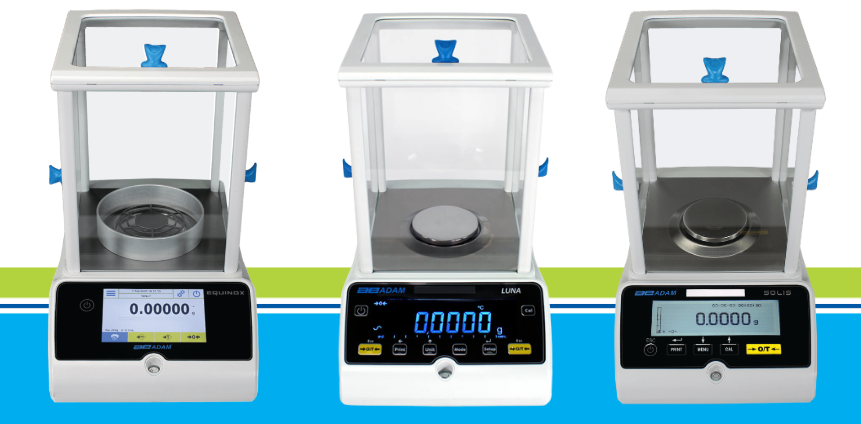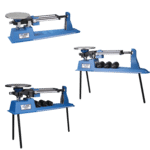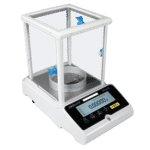
Laboratories have come to rely on scales and balances for a variety of purposes, such as formulating medicines and performing quality control. However, the highly accurate and precise semi-micro, analytical and precision balances we use for laboratory work weren’t always around. What did we use back then? This blog will discuss how humanity’s very first balances evolved into what we know today.
Egypt Invents the Balance
There’s evidence to support that the first balance was used in ancient Egypt, at least as far back as 2600 BC. Unfortunately, no balances from this time have survived. We know what they look like and how they operated from depictions in Egyptian murals, as well as the rudimentary “test weights” that were recovered.
These balances were center beam balances, with two plates attached to an overhead beam, then attached to a central pole. Reference weights, usually stone or another such material, were placed on one plate, and the weighing sample placed on another. When the plates were equal, the general weight of the sample would be known.
It's estimated that utilizing balances was a widespread practice in Ancient Egypt, as the ingenious invention was even integrated into their religious beliefs. Egyptians believed that when you died, your heart was weighed against a feather. Only if your heart was equally as light as the feather may you pass into the afterlife. The intention was to judge the quality of a person’s character and encourage good deeds throughout life. Even today, a beam balance represents truth and is often depicted in courthouses and other judicial locations held by a statue we call “Lady Justice.”

Mechanical Balances
Moving quickly through thousands of years of history (this isn’t a textbook!) the next big developments in mass measurement were spring and beam mechanical scales. Spring scales were invented in 1770. Instead of using known weights to balance an unknown weight like center beam balances, spring scales utilize gravity and measure the force required to stretch or compress a spring. The result is typically displayed vertically, like a thermometer, though it’s often displayed radially like a clock. The heavier the weight, the longer the spring extends, and the space created by the stretch is measured in grams or newtons. This type of scale is still widely available today but isn’t considered accurate or precise enough for laboratory use – however, you may have one in your kitchen!

Beam balances are more widely available and generally considered more accurate. Like the center beam, beam balances operate by comparing known weights with unknown weights. Our is an example. The TBB has three beams, with weights attached to each. One beam measures single grams up to ten, the second measures every 100 grams up to 500, and the third measures every ten grams up to 100. This can vary depending on the scale’s capacity. An item is placed on the pan and the weights are slid, heaviest to lightest, until the pointer is level with a mark on the other side of the balance. The numbers that the weights have slid to are added up, and that’s the weight of your sample. Nowadays, triple beam balances are more suited for science classrooms than professional laboratories, as they’re simple to operate and helpful for hands-on teaching about mass.

Electrical and Digital Scales and Balances
Mechanical scales are called such because they don’t require electricity or batteries to operate, as opposed to our modern electrical and digital scales that are the most widespread today. Digital scales were invented sometime around 1965 and are extremely versatile – really, there’s a digital scale for almost any application, many of which are discussed in other blogs of ours, such as What Are Weighing Scales Used For?
The most common weighing instruments for laboratories are precision, analytical and semi-micro balances. Analytical balances operate by way of force restoration, while precision balances may operate through either force restoration or with the use of load cells. Force restoration determines an unknown mass by balancing the force of the weight with another force created by a system of coils mounted in a magnetic field. Essentially, force restoration measures force the way our beam balances do, without any of the work on your part!
Load cells are transducers that convert force (weight) exerted onto it into measurable electrical output. To put it simply, when a weight is applied to a balance, the load cell located under the weighing pan bends, and the amount of force it takes to bend the load cell is converted to the result you get on the display. This method is similar to a spring scale!
Adam Equipment have capacities ranging from 120g to 22,000g, with readabilities from 0.001g to 0.1g. Our have capacities from 80g to 510g, with readabilities from 0.1mg to 0.0001g – significantly more precise and accurate. Finally, our and semi-micro balances have capacities from 62g to 82g, and readabilities from 0.01mg to 0.1mg.

Laboratories don’t only benefit from exceptional precision and accuracy – lab scales also offer additional applications, such as formulation, parts counting, checkweighing and dynamic weighing. In the times of beam or spring balances, these extra calculations would have to be done manually. Now, you save time, money, and effort when using one of our Equinox, Luna or Solis balances.
Extraordinary scientific research and developments have come about thanks to scales and balances used in laboratories – yes, even before they became as accurate as the ones we use now. Imagine what will come!
For questions on which lab balance is right for you, contact us, we’re here to help.





